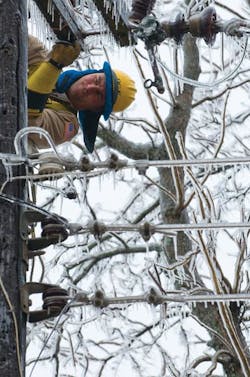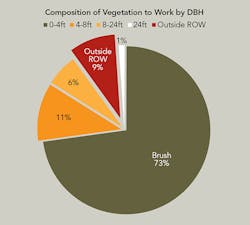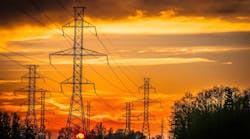Seven years ago, a severe ice storm halted power to more than 300,000 customers of Oklahoma Gas & Electric Co. (OG&E) with some outages lasting up to two weeks. The utility, together with the Oklahoma Corporation Commission, determined a plan was needed to increase the durability of its system and reduce the impact of major storms on its customers.
Following the storm, OG&E worked closely with the commission to explore solutions. For example, one option was for the utility to bury all of its power lines. However, this was not a feasible alternative as it would have increased customers’ bills by $80 to $250 per month. OG&E then began working with Davies Consulting. Together, they devised a plan for system hardening over a three- to six-year implementation. After conducting a rigorous review of the options, the OG&E–Davies team presented a proposal to the commission.
The utility and the commission explored several strategies to harden the system, but they ultimately decided to focus on two key areas. Because weather events cause a wide variation in system average interruption duration index (SAIDI) numbers each year, and vegetation management significantly affects the severity of outages, OG&E zeroed in on a combination of vegetation management and system hardening to make its system more resilient.
Establishing a Four-Year Cycle
As part of the system hardening, the Tree Line USA certified utility focused on several high-value vegetation management activities, including establishing a four-year cycle, increasing clearance, removing overhang, targeting high-value removals and adopting a wider use of chemical control.
Cycle lengths of three to four years are generally optimal when considering cost and addressing reliability. While shorter cycle lengths may improve reliability, they are often not as economical. Longer cycle lengths, on the other hand, reduce reliability and the cost of maintenance increases dramatically.
The commission recommended OG&E adopt a four-year cycle, which would give the utility’s customers excellent reliability while controlling costs. To complement this cycle, OG&E increased its tree clearance from 8 ft to 10 ft for slow-growing species and 14 ft for other species. By adopting the increased clearances, it dramatically reduced the number of cycle busters and, subsequently, the number of tree incidents through an aggressive clearance approach.
Controlling Vegetation
OG&E found that there are two effective ways to reduce vegetation outages and cost: reduce the amount of vegetation or find more economical ways to manage it. For example, the utility’s system hardening program allowed OG&E to identify and address overhanging branches, which are typically more technical and expensive to clear. Because fall-ins can contribute to outages with a long duration, removing overhang reduces the restoration time and lowers future maintenance costs.
One option was to prune the trees, but this is only a temporary solution because the tree grows back and requires future maintenance. Inflation and growth escalate the cost of pruning each time it’s performed. Also, the tree remains as a potential contributor to future outages and liability. Growth regulators can help, but removals offer a long-term solution. Since removals can be expensive, OG&E began by targeting trees that could be removed in less than twice the time it takes to prune them. This was determined to provide the best value for system hardening. To make target identification easy, OG&E provided the contractor with a simple rule based on trunk
diameter: 8-inch diameter at breast height (DBH).
The utility discovered that 11% of the trees on the system were 4-inch to 8-inch DBH. Because it was cost prohibitive to remove all of these trees at once, the decision was made to clear them in stages. Trees within 10 ft of a pole would be the first targeted for removal. Targeting trees near poles complemented other aspects of system hardening by aiding the troubleshooter and the line crew with visual and physical access.
Large trees were a bigger issue, because trees pruned for line clearance are not generally aesthetically pleasing. As such, the vegetation group identified large trees along the major thoroughfares and high-visibility areas for removal.
While removals improved system resilience and reduced future workload, there remained an extensive amount of young vegetation or “brush” that, if left unchecked, would contribute to future outages and expenditures. The contractor was instructed to treat or remove all brush within 5 ft of center. The cost to treat — rather than cut, drag, chip, haul and treat — was determined to be about 75% lower. Treating brush became the preferred management method due to cost and the lower potential for injury and environmental impact.
OG&E also aggressively expanded herbicide use into urban areas. The contractors were instructed to use discretion, but consider any brush shorter than 6 ft and smaller than
4 inches to be a candidate for treatment.
Hardening Circuits
In addition to the vegetation management program, circuit hardening played a key role in making OG&E’s system more robust and resilient. For the circuit hardening program, OG&E and Davies first had to determine which circuits needed the most attention. To prioritize the circuits, they examined several factors including the number of customers, the number of critical customers served, and the amount of underground and overhead miles. They also took into account the distance from the circuit to the operating headquarters to calculate how long it would take troubleshooters to reach the location in an emergency. Additional considerations included ties to other circuits, tree density, equipment age and even accessibility of yards versus equipment-ready locations.
Another factor was whether the overhead lines were made of copper or steel. When copper ages, it can get brittle or stretch. In these instances, linemen can have difficulty repairing it using a splice when there is damage. If they do not have the right materials on hand, they must cut out the section, build a new structure and replace it with new wire, which lengthens the restoration time. For that reason, OG&E prefers steel-reinforced aluminum to copper for its overhead lines.
Prioritizing Projects
After gathering comprehensive data on each circuit, the utility determined the level of hardening required by circuits needing attention.
If a circuit was designated as a Level 1, the linemen would bring pole construction up to current standards by replacing wood insulator pins, braces and single crossarms with more durable structures. They also would make general improvements, excluding replacing the pole.
On Level 2 circuits, the linemen would strengthen the support structure, increase the pole size, improve the strength of the guy wires and anchors, and bring it up to current standards.
Those structures characterized as Level 3 would include the same repairs as Level 1 and 2, as well as the replacement of small conductor or copper conductor with larger wires. Also, if the structure was located in a heavily treed area, then the linemen would add self-supporting aerial cable. This cable has a steel support wire so it is stronger, and, instead of being an open wire, it has a jacket so tree contact will not cause a fault on the wire.
Level 4 circuits required a major redesign, which would upgrade the distribution line to Grade B construction. As the utility’s strongest guideline for how to size poles, Grade B is commonly used for poles that cross highways or railroads. These circuits are considered critical, and because they can be the most expensive circuits to repair, the utility would upgrade the pole size from Class 5 to Class 3 or from Class 3 to Class 1.
In addition, the linemen would shorten the spans on Level 4 circuits to cause less wind loading on the lines. By replacing the crossarms and upgrading down guys and anchors, the field crews also could reduce the impact of ice and wind loading on the line.
If the circuits were labeled Level 5, then the lines would need to be buried underground. At this level, the feeder lines coming from the substation would remain overhead but be brought up to Grade B construction, and lateral lines would be converted to underground construction.
Forging Ahead
The next step was to put together a plan that included analysis of how all the circuits ranked against one another. OG&E put together a portfolio of projects selected to best achieve its goals and manage program costs. The utility also brought construction contractors onboard specifically to execute this plan over the course of the program. In turn, the commission added a special regulatory rider into the rate base that was above the normal spending level to fund the projects for the benefit of customers.
In 2010, construction began, and the first step in the implementation took three years. In 2013, OG&E returned to the commission and asked for a one-year extension, so the project ended up lasting four years. During that time frame, contractors worked on 103 different distribution circuits, which impacted more than 100,000 customers and 700 miles of distribution lines.
To evaluate the success of its program, the utility established measures of resilience and durability. For example, OG&E defined circuit resilience as the ability to continue to operate despite damage. To measure that, OG&E looked at the number of outages occurring on the circuit and compared them over time to nearby circuits that did not receive any circuit hardening. From 2011 to 2013, the hardened circuits had a 53% drop in outages compared to the nonhardened circuits.
Circuit durability is defined as the ability to withstand storms with minimal damage. Whenever a storm occurs, the utility measures the quantity of poles it needs to replace per overhead mile as a proxy for overall equipment damage. During four major storm events in 2013, hardened circuits required less than 10% of the equipment replacements seen on nearby nonhardened circuits.
Through system hardening and its vegetation management program, OG&E is making its system more robust and more resistant against outages, both now and in the future.
Ryan Jones ([email protected]) is a senior asset management engineer for OG&E.
Jarod Cassada ([email protected]) is a forester for OG&E.
Don Ciupak ([email protected]) is the manager of asset management at OG&E.
Editor’s note: During the hardening projects, OG&E followed the guidelines of the Electric Utility Industry Sustainable Supply Chain Alliance, which consists of 17 of the largest utilities in the U.S. The goal of the alliance is to improve environmental performance and advance sustainable business practices. For more information, visit http://euissca.org.
Mentioned in this article:
Davies Consulting | www.daviescon.com
Oklahoma Gas & Electric | www.oge.com





